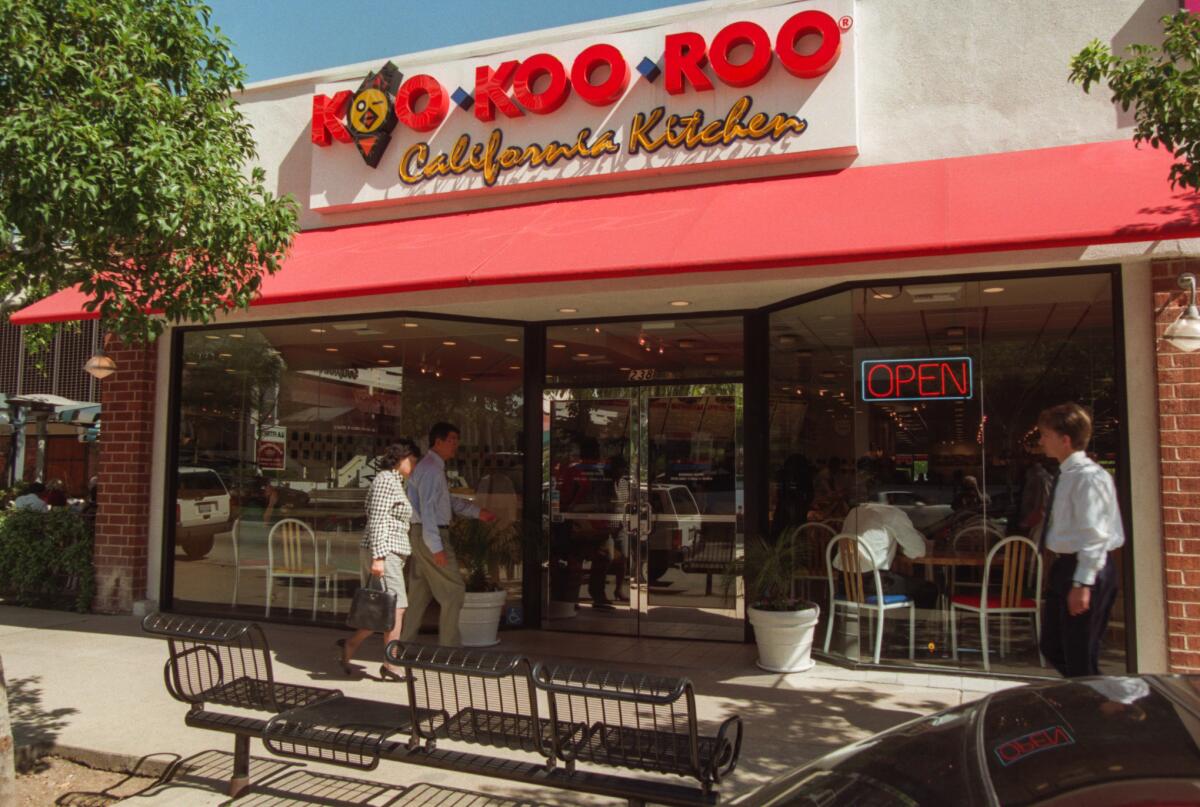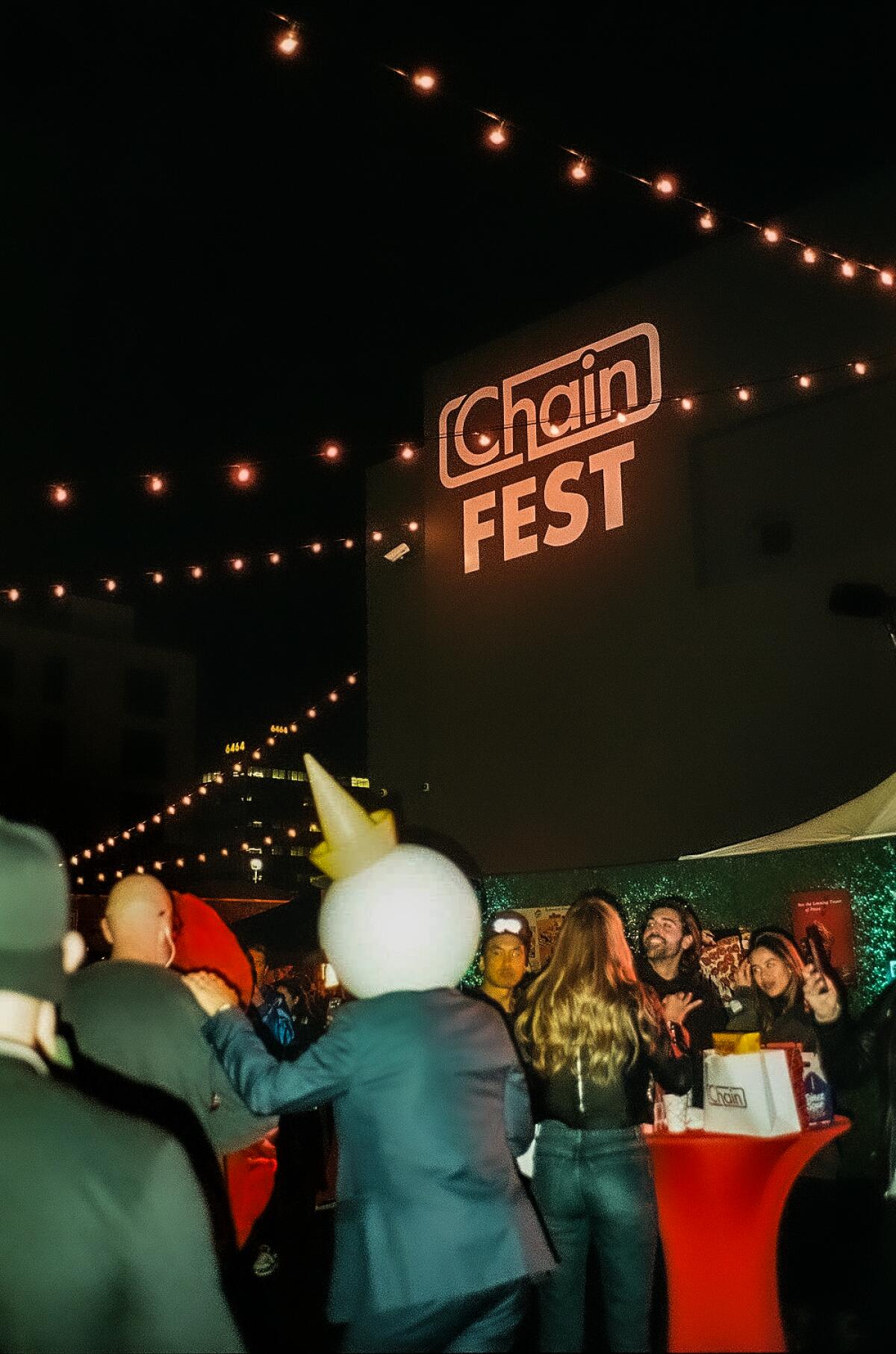Koo Koo Roo’s comeback: Everything to know about the beloved chicken chain’s return

- Share via
The news spread like wildfire, and it was all about flame-grilled chicken: Beloved chain restaurant Koo Koo Roo is coming back under new ownership.
The prolific chain with a stronghold in L.A. ran from 1988 to 2014, and though the specialty was skinless grilled chicken, its countless sides, salads, sandwiches and other items from the restaurant with a cult following have echoed in the minds of fans for years since the last store shuttered in Santa Monica a decade ago.
“I feel like I’m a steward of something very important,” said new owner and Chief Executive Daniel Farasat. “I’ve been very protective of the brand and making sure that we bring it back the right way. … It’s really an ode to L.A.”
Farasat, who acquired the company in 2022, has been plotting Koo Koo Roo’s return and while many of his plans are still in the works — such as specific menu items and the first bricks-and-mortar location — he knows he’ll be serving the chain’s original recipes, along with a few new items, with a focus on natural foods and local sourcing.
Once in a while a fast food restaurant comes along whose product catches my eye; Koo Koo Roo’s skinless char-broiled chicken is one.
Though the chicken chain won’t fully return until late next year, fans can get a first taste Oct. 5 at ChainFest, where it will pop up alongside more than a dozen other chains and brands, including White Castle, Trader Vic’s and Red Lobster.
The playful event is run by some of entertainment’s biggest names, including B.J. Novak, Chrissy Teigen and chef and culinary TV personality Tim Hollingsworth. Chain serves gourmet spins on fast-food items from some of the world’s largest chain restaurants, sometimes through one-off pop-ups at its headquarters in Virgil Village, and other times through ChainFest, the company’s sprawling, ticketed signature festival.
Koo Koo Roo’s new owner said the outpouring since Tuesday’s festival announcement has been “enormous,” with thousands of interactions on social media, countless DMs, hundreds of comments, texts from people he hasn’t spoken with in a long time and phone calls for meetings.
Some of those responses have been from former Koo Koo Roo employees volunteering their institutional knowledge or offering to come back on board.
Farasat’s memories of the chicken chain span decades, from his younger years when he went with his family, to high school, ducking in after class or football games with friends. In adulthood, he would stop by on his lunch breaks from work.
During the pandemic, Farasat, an investor and real estate developer, was looking for a new project when he read that the parent company of Koo Koo Roo was liquidating.
Everyone knows the fast-food industry is in a pickle.
He trolled LinkedIn profiles, trying to locate anyone who might be involved with the company, sending blind messages. Around six months later, in 2022, he acquired the chain’s intellectual property, which includes all of Koo Koo Roo’s original recipes, its logos, its operation manuals — everything still on file for the defunct but iconic restaurant.
Koo Koo Roo is his first restaurant. His wife, Hila (formerly of Sprout restaurant group), is helping to navigate the restaurant operations while his brother, Raphael, the CEO of branding agency Truffl, is heading up the visual rebranding.
They’re planning community events and pop-ups to reintroduce Koo Koo Roo under its new ownership, then expect to open with one restaurant in late 2025 — and, hopefully, proceed to open more.
“When Koo Koo Roo started, everything was handmade, hand-marinated,” he said, “and that’s the Koo Koo Roo that we’re trying to bring back.”
The first Koo Koo Roo
Brothers Ray and Mike Badalian opened their first Koo Koo Roo in 1988 in Koreatown, where the lines for flame-grilled skinless chicken would sometimes form down the block.
That year, former L.A. Times Food writer Rose Dosti praised Koo Koo Roo for its health-forward cooking that didn’t sacrifice flavor, calling it “something to crow about” and writing: “This could be the beginning of a new trend for fast food chicken. Others are bound to respond to the koo-koo-roo of the times.”
A precursor to the fast-casual movement, the chain was often referred to as “healthier fast food”; its owners hoped to not only cook without butter or oil but also add a touch of class with nonplastic flatware and flowers on tables. These touches seemed to work, with fandom and restaurants growing rapidly.

But the beloved chicken chain struggled financially for years, navigating the highs and lows of public trading, acquiring other companies — including Hamburger Hamlet and Color Me Mine — and passing between or merging with multiple conglomerates as it changed names, chased profitability and planned expansions along both coasts.
The chain filed for bankruptcy in 2003 and was later acquired by Magic Brands LLC. In 2010, that company also filed for bankruptcy and shuttered 10 Koo Koo Roos, leaving Santa Monica, Larchmont and West Hollywood standing. The company cited the high cost of commercial rent in Southern California, in addition to a competitive market and frequent menu changes that confused customers.
Luby’s Restaurant Corp. purchased Koo Koo Roo in 2010, but the stability was short-lived. The company shuttered all three locations, flipping the last-standing Koo Koo Roo, in Santa Monica, into a Fuddruckers in 2014. By the time it closed, the last location offered meatballs, burgers, meatloaf and chicken burritos in addition to chicken plates, sides and salads.
Determining which items to bring back is proving difficult for the Farasats.
“If you look at a menu from 1988 or 1993 or 2010, it’s a very different menu,” Daniel Farasat said. “We’ve had an enormous response from people since we announced the launch, and a lot of that is about people’s favorite dishes. … We’re trying to really take community input into the equation as we figure out the final menu.”
His own favorite items — the chicken sandwiches, the chicken plate and the Caesar salad — could very well end up on the menu, as could the sides.
The menu for its debut at ChainFest in October is also still in the works, but Nicholas Kraft, Chain’s chief creative officer and a lifelong Koo Koo Roo fan, hinted that there could be multiple iconic sides on offer.

Months ago, when Chain jokingly posted to Instagram that its mission was to bring back Koo Koo Roo, the onslaught of DMs in response floored the team. They immediately sought to find the new owners for possible collaboration. Chain’s team views its pop-ups and festivals as “a platform for pop cuisine.”
“There’s a whiteboard with a lot of dreams at Chain,” said Kraft. “How realistic we think any of them necessarily are is another story, but once we started getting all these responses and realized someone does own the rights to Koo Koo Roo, it very much became the mission of: How do we, at the very least, just politely yell at them to get a move on with the comeback?”
Koo Koo Roo was slated to appear only in ChainFest’s VIP section, but according to Kraft, this week’s overwhelming response is causing them to rethink the decision, and possibly move it to the general-admissions area.
ChainFest also will resurrect another bygone L.A. institution: Trader Vic’s, the iconic tiki bar that popularized the mai tai, will be popping up with help from Historic Filipinotown bar Thunderbolt.
The iconic restaurant in Beverly Hills was quietly downsized last month, without the send-off some fans feel it should have gotten.
Other participants include White Castle, which will serve a collaborative take on its 1921 slider featuring a special sauce from Hollingsworth; Red Robin, which will offer a Hollingsworth take on the chain’s spicy burger, as well as his creation of triple-pickle onion rings; Panda Express, which will be previewing a new item; and more.
ChainFest takes place Oct. 5 at the ROW DTLA complex in the Arts District, with lower ticket prices for early buyers. Tickets go on sale Friday; general admission tickets include bites from each station, access to entertainment and a cash bar for $89.99 to $149.99. VIP tickets include unlimited bites, an open bar, VIP-only dishes and access to exclusive areas for $299.99 to $499.99.
More to Read
Eat your way across L.A.
Get our weekly Tasting Notes newsletter for reviews, news and more.
You may occasionally receive promotional content from the Los Angeles Times.











